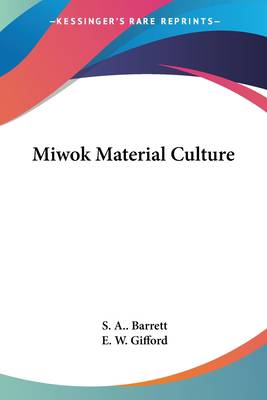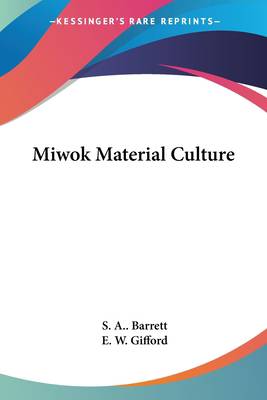
- Retrait gratuit dans votre magasin Club
- 7.000.000 titres dans notre catalogue
- Payer en toute sécurité
- Toujours un magasin près de chez vous
- Retrait gratuit dans votre magasin Club
- 7.000.0000 titres dans notre catalogue
- Payer en toute sécurité
- Toujours un magasin près de chez vous
Description
Miwok Material Culture is a detailed examination of the material culture of the Miwok people, a Native American tribe from California. The book was written by S. A. Barrett, an anthropologist who conducted extensive fieldwork among the Miwok in the early 20th century. The book covers a wide range of topics related to Miwok material culture, including their housing, clothing, tools, weapons, and food. Barrett provides detailed descriptions of each of these aspects of Miwok life, drawing on his own observations as well as historical and archaeological records. One of the key themes of the book is the way in which Miwok material culture reflects their environment and way of life. For example, Barrett notes that the Miwok used a wide variety of plant and animal materials in their clothing and tools, reflecting the diversity of resources available in their region. Similarly, he describes how Miwok housing was designed to be portable and adaptable, allowing them to move frequently in response to changing environmental conditions. Throughout the book, Barrett also explores the cultural significance of Miwok material culture, examining the ways in which different objects and practices were imbued with meaning and symbolism. For example, he describes the importance of dance regalia in Miwok culture, and how different types of clothing and accessories were associated with specific dances and rituals. Overall, Miwok Material Culture is a valuable resource for anyone interested in the history and culture of the Miwok people, as well as for scholars of anthropology, archaeology, and Native American studies more broadly.Bulletin Of The Public Museum Of The City Of Milwaukee.This scarce antiquarian book is a facsimile reprint of the old original and may contain some imperfections such as library marks and notations. Because we believe this work is culturally important, we have made it available as part of our commitment for protecting, preserving, and promoting the world's literature in affordable, high quality, modern editions, that are true to their original work.
Spécifications
Parties prenantes
- Auteur(s) :
- Editeur:
Contenu
- Nombre de pages :
- 360
- Langue:
- Anglais
Caractéristiques
- EAN:
- 9781428661684
- Date de parution :
- 25-07-06
- Format:
- Livre broché
- Format numérique:
- Trade paperback (VS)
- Dimensions :
- 152 mm x 229 mm
- Poids :
- 526 g

Les avis
Nous publions uniquement les avis qui respectent les conditions requises. Consultez nos conditions pour les avis.






